小型レーザーモジュール、フォノジャック付き

- Wavelengths from 405 nm to 980 nm
- Collimated and Adjustable-Focus Versions
- Compact Ø8 mm or Ø11 mm Housing Options
CPS532
Collimated Laser Module
Power Supply Not Included
Application Idea
Adjustable-Focus Laser Module Mounted in a KM100 Using an AD11NT Adapter
Elliptical or Round Beam Profiles
The CPS1 includes both a USB-to-Micro-USB cable and a custom USB-to-Phono cable.

Please Wait
| Table 1.1 Quick Links |
|---|
| Laser Diode Modules |
| 405 nm - 532 nm |
| 635 nm |
| 650 nm - 780 nm |
| 830 nm - 980 nm |
| Accessories |
| Mounting Adapters |
| Kinematic Mount |
| Laser Module Kit |
| 5 VDC Power Supplies |
| 5 VDC Battery Pack |


特長
- コリメート型または焦点調整型レーザーモジュール
- 小型のØ8 mmまたはØ11 mmの筐体で、アライメントレーザとして利用可能
- 波長範囲405 nm~980 nmのレーザ(Table 1.1参照)
- 4種類の635 nmレーザはHeNeレーザの代用品として使用可能
- 円形または楕円形のビームプロファイルから選択可能
- 内蔵のフォトダイオードフィードバックを利用した定出力モード
- 電源や、電源と筐体付きのレーザーモジュール取付けキットもご用意
こちらのフォノジャック付きレーザーモジュールは、コリメート型および焦点調整型をご用意しており、出力は0.85 mW~4.5 mWでラインナップしています(レーザ安全基準のクラスは2または3Rでモデルによって異なります)。各モジュールの出力ビーム形状は楕円形または円形で、それぞれ下の表に記載されています。空間的にシングルモードのレーザを出力し、小型で円筒状の筐体に納められていることから、光学系内のアライメントレーザとしての使用に適しています。
すべてのCPSシリーズレーザーモジュールは、内蔵フォトダイオードからのフィードバックを利用して光出力パワーを一定に維持する、定出力モードで駆動します。しかしこれらのレーザは温度安定化されていないため、動作中の光出力が若干変動する可能性があります。
電源について
各モジュールの動作には5 VDCが必要です(レーザーモジュールには電源は付属しません)。USB-フォノケーブルアダプタCPSAは、USB出力の5VDC電源やモバイルバッテリに利用可能です。
| 各種資料のご案内 | |
|---|---|
| 仕様や図面等の情報は、仕様表内のInfo欄の青いアイコンから取得可能です。 | |
また、お客様がお持ちの電源をモジュールに接続する場合には、付属の2.5 mmオス型フォノプラグをお使いいただけます。モジュールには、電源接続用に2.5 mmメス型フォノソケット付きの長さ457 mmまたは610 mmのケーブルが付いています。
取付けについて
Ø8 mmならびにØ11 mmの筐体は、Figure 1.2、1.3、1.4、1.5のような取付け用アダプタを使用することにより当社のオプトメカニクス部品のラインナップに取り付けることができます。アダプタを使用することによって、レーザーモジュールはSM1内ネジ付きマウントやØ25.4 mm(Ø1インチ)穴付きマウントに直接取り付けることが可能です。各アダプタの詳細と当社のオプトメカニクス部品との適合性については下記をご覧ください。
当社では、Ø11 mmのレーザーモジュール用にミニシリーズのキネマティックマウントもご用意しています。このマウントは当社の製品の中ではもっとも小型のキネマティックマウントで、Ø6 mmミニシリーズポストに取り付けられるようにM3タップ穴が付いています。
また、キネマティックマウントKM100T、ポスト、ポストホルダ、べース、そして5 VDC電源をすべてセットにしたモジュール取付けキットをご用意しております。レーザーモジュールCPS635F、CPS650F、CPS670Fに付いている焦点調整用の刻み付きノブは、取付けアダプタの内孔よりも大きくなっていますのでご注意ください。焦点調整型モジュールをコリメート型と同様の方法で取り付けるために、ノブを一旦取り外すことができます。取り外す前にノブを固定している止めネジ(セットスクリュ)を緩めてください。緩めずに作業するとネジを破損させる恐れがあります。また、初めにコードとフォノプラグをアダプタに通してからモジュールに取り付けてください。
※ 本製品は、円筒の金属筐体部がグランドになっておらず、電源のグランドに対して数Vの電位を持っている場合があります。このため、金属筐体を電源グランドと接続するような使い方をするとレーザーモジュールが点灯しなくなる場合があります。
レーザCPS電源用コネクタ
LDS5の電源用コネクタ

レーザの安全性とクラス分類
レーザを取り扱う際には、安全に関わる器具や装置を適切に取扱い、使用することが重要です。ヒトの目は損傷しやすく、レーザ光のパワーレベルが非常に低い場合でも障害を引き起こします。当社では豊富な種類の安全に関わるアクセサリをご提供しており、そのような事故や負傷のリスクの低減にお使いいただけます。可視域から近赤外域のスペクトルでのレーザ発光がヒトの網膜に損傷を与えうるリスクは極めて高くなります。これはその帯域の光が目の角膜やレンズを透過し、レンズがレーザーエネルギを、網膜上に集束してしまうことがあるためです。
安全な作業および安全に関わるアクセサリ
- クラス3または4のレーザを取り扱う場合は、必ずレーザ用保護メガネを装着してください。
- 当社では、レーザのクラスにかかわらず、安全上無視できないパワーレベルのレーザ光線を取り扱う場合は、ネジ回しなどの金属製の器具が偶然に光の方向を変えて再び目に入ってしまうこともあるので、レーザ用保護メガネを必ずご使用いただくようにお勧めしております。
- 特定の波長に対応するように設計されたレーザ保護眼鏡は、装着者を想定外のレーザ反射から保護するために、レーザ装置付近では常に装着してください。
- レーザ保護眼鏡には、保護機能が有効な波長範囲およびその帯域での最小光学濃度が刻印されています。
- レーザ保護カーテンやレーザー安全保護用布は実験室内での高エネルギーレーザの遮光にご使用いただけます。
- 遮光用マテリアルは、直接光と反射光の両方を実験装置の領域に封じ込めて外に逃しません。
- 当社の筺体システムは、その内部に光学セットアップを収納し、レーザ光を封じ込めて危険性を最小限に抑えます。
- ピグテール付き半導体レーザは、他のファイバに接続、もしくは他のファイバとの接続を外す際には、レーザ出力をOFFにしてください。パワーレベルが10 mW以上の場合には特にご注意ください。
- いかなるビーム光も、テーブルの範囲で終端させる必要があります。また、レーザ使用中には、研究室の扉は必ず閉じていなければなりません。
- レーザ光の高さは、目線の高さに設定しないでください。
- 実験は光学テーブル上で、全てのレーザービームが水平を保って直進するように設定してください。
- ビーム光路の近くで作業する人は、光を反射する不要な装飾品やアクセサリ(指輪、時計など)をはずしてください。
- レンズや他の光学装置が、入射光の一部を、前面や背面で反射する場合がありますのでご注意ください。
- あらゆる作業において、レーザは必要最小限のパワーで動作するようにご留意ください。
- アライメントは、可能な限りレーザの出力パワーを低減して作業を行ってください。
- ビームパワーを抑えるためにビームシャッタや フィルタをお使いください。
- レーザのセットアップの近くや実験室には、適切なレーザ標識やラベルを掲示してください。
- クラス3Rやクラス4のレーザ(安全確保用のインターロックが必要となるレーザーレベルの場合)で作業する場合は、警告灯をご用意ください。
- ビームトラップの代用品としてレーザービュワーカードを使用したりしないでください。
レーザ製品のクラス分け
レーザ製品は、目などの損傷を引き起こす可能性に基づいてクラス分けされています。国際電気標準会議(The International Electrotechnical Commission 「IEC」)は、電気、電子工学技術関連分野の国際規格の策定および普及を行う国際機関で、IEC60825-1は、レーザ製品の安全性を規定するIEC規格です。レーザ製品のクラス分けは下記の通りです
| Class | Description | Warning Label |
|---|---|---|
| 1 | ビーム内観察用の光学機器の使用を含む、通常の条件下での使用において、安全とみなされているクラス。このクラスのレーザ製品は、通常の使用範囲内では、人体被害を及ぼすエネルギーレベルのレーザを発光することがないので、最大許容露光量(MPE)を超えることはありません。このクラス1のレーザ製品には、筐体等を開かない限り、作業者がレーザに露光することがないような、完全に囲われた高出力レーザも含まれます。 |  |
| 1M | クラス1Mのレーザは、安全であるが、望遠鏡や顕微鏡と併用した場合は危険な製品になり得ます。この分類に入る製品からのレーザ光は、直径の大きな光や拡散光を発光し、ビーム径を小さくするために光を集束する光学素子やイメージング用の光学素子を使わない限り、通常はMPEを超えることはありません。しかし、光を再び集光した場合は被害が増大する可能性があるので、このクラスの製品であっても、別の分類となる場合があります。 |  |
| 2 | クラス2のレーザ製品は、その出力が最大1 mWの可視域での連続放射光に限定されます。瞬目反射によって露光が0.25秒までに制限されるので、安全と判断されるクラスです。このクラスの光は、可視域(400~700 nm)に限定されます。 |  |
| 2M | このクラスのレーザ製品のビーム光は、瞬目反射があるので、光学機器を通して見ない限り安全であると分類されています。このクラスは、レーザ光の半径が大きい場合や拡散光にも適用されます。 |  |
| 3R | クラス3Rのレーザ製品は、直接および鏡面反射の観察条件下で危険な可視光および不可視光を発生します。特にレンズ等の光学機器を使用しているときにビームを直接見ると、目が損傷を受ける可能性があります。ビーム内観察が行われなければ、このクラスのレーザ製品は安全とみなされます。このクラスでは、MPE値を超える場合がありますが、被害のリスクレベルが低いクラスです。可視域の連続光のレーザの出力パワーは、このレベルでは5 mWまでとされています。 |  |
| 3B | クラス3Bのレーザは、直接ビームを見た場合に危険なクラスです。拡散反射は通常は有害になることはありませんが、高出力のクラス3Bレーザを使用した場合、有害となる場合もあります。このクラスで装置を安全に操作するには、ビームを直接見る可能性のあるときにレーザ保護眼鏡を装着してください。このクラスのレーザ機器にはキースイッチと安全保護装置を設け、さらにレーザ安全表示を使用し、安全照明がONにならない限りレーザがONにならないようにすることが求められます。Class 3Bの上限に近いパワーを出力するレーザ製品は、やけどを引き起こすおそれもあります。 |  |
| 4 | このクラスのレーザは、皮膚と目の両方に損傷を与える場合があり、これは拡散反射光でも起こりうるとみなされています。このような被害は、ビームが間接的に当たった場合や非鏡面反射でも起こることがあり、艶消し面での反射でも発生することがあります。このレベルのレーザ機器は細心の注意を持って扱われる必要があります。さらに、可燃性の材質を発火させることもあるので、火災のリスクもあるレーザであるとみなされています。クラス4のレーザには、キースイッチと安全保護装置が必要です。 |  |
| 全てのクラス2以上のレーザ機器には、上記が規定する標識以外に、この三角の警告標識が表示されていなければいけません。 |  | |
| Posted Comments: | |
Hyuk Jeong
(posted 2025-05-12 13:04:16.55) How long is the lifetime? hchow
(posted 2025-05-13 05:24:16.0) Dear Hyuk Jeong, thank you for your feedback. The mean time to failure (MTTF) of the laser diodes used in the CPS series is roughly 10,000 hours. Hyungchul Park
(posted 2025-02-18 12:44:53.423) Hello, I am trying to characterize the beam with M2 parameter. And when doing so I found that the eigen-axis of the spot ellipse rotate on propagation distance which is indication of general astigmatism.
So my question is, is the laser collimination achieved by the cylindrical lens? I think if the focusing achieved by the spherical lens, there should be no general astigmatism, even though simple astigmatism might be present. hkarpenko
(posted 2025-02-18 10:46:49.0) Dear customer,
thank you for your request. These laser modules aren´t tested for astigmatism, thus your measurement results might be correct. I will contact you directly to find the source of the issue. Gabriela Valencia
(posted 2024-12-09 00:26:27.063) Dear Thorlabs team,
I am using this laser to measure its coherence length using a Michelson interferometer. I have reviewed the Spec Sheet to get an idea of the width of the spectrum, to relate that data to the coherence length of the laser. I think the coherence length should be a few centimeters at most. Experimentally, however, the interference pattern persists over a 139 mm mirror path, corresponding to an optical path difference of 270 mm, which exceeds the expected coherence length.
In addition, the visibility of the interference pattern exhibits oscillatory behavior rather than disappearing completely. There are maximum and minimum points of visibility along this distance, at some points of the optical path the interference pattern is very clear, at others it looks more faded but does not disappear, then again it looks very clear, and so on. This is independent of any additional components (e.g. ND filter, retroreflector mirror, spatial filtering).
With this in mind, my question is, what does the spectrum of this laser actually look like, and is it possible that it is similar to the CPS532-C2 laser, where this behavior could be explained by the shape of the spectrum. It has a longer coherence length and the characteristic "beating" pattern that I observed.
Thank you in advance for any information you may have on this matter.
Best regards,
Gabriela hkarpenko
(posted 2024-12-09 10:30:17.0) Dear customer,
thank you for your feedback. The spectra of the lasers CPS532 and CPS532-C2 are quite different. CPS532 has a quite broad spectrum whereas CPS532-C2 has a narrow multiline like spectrum. Therefore, I expect a longer coherence length for the latter one. I will contact you directly to discuss this issue further with you. Hyungchul Park
(posted 2024-07-24 12:42:42.533) We are using CPS532 and it turns out that beam quality is critical with regard to our application. So is the higher order TEM modes excited at the laser cavity? And what would be the M2 factor of the beam. Thank you in advance. hkarpenko
(posted 2024-07-24 08:48:33.0) Dear Hyungchul Park,
thank you very much for your feedback. These laser modules aren´t specifically designed to have very stable output power and good M² value, that is needed for certain applications. Thus we don´t state an M² value for these. Higher harmonics of this laser are blocked using filtersets, but cannot be fully excluded. I will contact you directly to discuss this further with you. yujie lu
(posted 2023-10-31 10:13:44.527) 具体的配套器件 fmortaheb
(posted 2023-11-02 10:59:48.0) Thank you very much for contacting us. An application engineer from our team in China will discuss this directly with you. craig uhrich
(posted 2023-09-12 08:09:14.29) For these laser modules, I think it would be helpful to know the polarization quality and direction of the beams. A simple extinction ratio (e.g. 100:1) would tell how polarized the beam is, and for elliptical beams it would be important to know the direction of polarization relative to the beam axes. Don't need values with one degree resolution, but it would be nice to know if the polarization is roughly along the long or short axes of the beam shape. Thanks. Conner Phillips
(posted 2023-07-25 13:52:39.837) I am looking into using either a CPS830(S) or CPS850(S) for alignment of an optical system using a shearing interferometer. While the individual peaks in the respective spectra are quite narrow, the presence of multiple peaks in a 1-2 nm range could be problematic I guess. Do you have any insight on these products in this application? Thanks you. hkarpenko
(posted 2023-07-28 08:40:25.0) Dear Conner,
thank you for your feedback. The FWHM of this laser module is ~2nm. We measure the spectrum for each device seperately and this is also included in the test report, which we send out with the device. I will contact you directly to discuss this issue in more detail with you. Dmitry Murzin
(posted 2023-03-25 13:41:28.69) Hi! Does the polarization state of a CPS532 series laser diode drift over time? Thank you. dpossin
(posted 2023-03-28 07:29:20.0) Dear Dmitri,
We do not test this but the polarization should stay the same along the entire life time. user
(posted 2023-02-02 12:12:02.353) We purchased a CPS532-C2 a while ago and now it is broken. The reason for that issue is, that the part "boots holder_5" was loose. So that part turned several times over time and that lead to a wire break. It there an option to deassemble the internal PCB for soldering the wires to the PCB again? hchow
(posted 2023-02-02 10:51:22.0) Dear User, thank you for your feedback. As the problem you are facing is unique, I will reach out to you personally to discuss possible solutions to your problem. Thank you. Christopher Ebbers
(posted 2022-11-29 10:56:19.073) I just received my CPS520 laser source. The data sheet indicates the actual emission wavelength is 517 nm.
My application requires a wavelength between 520nm - 530 nm.
Is there any way to get a CPS520 within these longer wavelength parameters (ideally as close as possible to 523 nm)
Thanks in advance
Chris cdolbashian
(posted 2022-12-02 04:09:31.0) Thank you for reaching out to us with this inquiry. This is potentially possible for us to do! I have reached out to you directly to initiate this process. For future custom-adjacent request, please contact Techsales@thorlabs.com. 高 高
(posted 2022-09-19 14:45:08.003) 我想了解一下带USB的激光模块和带插孔的激光模块的具体差别,以及635nm的这款激光器的光谱线宽 Ana Doblas
(posted 2022-08-23 15:42:25.263) Hi! I would like to know if one can control the CPS532 diode automatically with software. wskopalik
(posted 2022-08-24 09:28:21.0) Thank you very much for your feedback!
The CPS532 as well as the other CPS modules cannot be controlled directly on a computer. They do not have a computer interface. You could however use a power supply / voltage source with a computer interface. Then you could control the power supply on the computer and use it to switch the CPS532 on and off.
I will contact you directly to provide further assistance. Terry Bartlett
(posted 2022-04-18 12:23:19.01) You mention that these compact phono jack lasers come with elliptical or round beam profiles, but in the description it looks like all come with elliptical profiles. Is it possible to get a CPS450 with a round beam profile? cdolbashian
(posted 2022-04-20 04:49:21.0) Thank you for reaching out to us Terry! The statement above is simply indicating that some of the CPS lasers have circular profiles while others are elliptical. Although the one you are interested in is elliptical, we do have a nice investigation on our "Lab Facts" showing different methods of circularizing a beam:https://www.thorlabs.com/newgrouppage9.cfm?objectgroup_id=11426. Petteri Teikari
(posted 2021-10-26 12:19:13.59) Hi,
I was interested in measuring the laser (junction) temperature or the temperature of the heatsink? Is there a recommended procedure for that?
Or can you assume safely that the laser module (e.g. we have your CPS532) will run at room temperature if mounted properly (proper heat dissipation) with no wavelength shifft?
Best
Petteri soswald
(posted 2021-10-29 07:55:15.0) Dear Petteri,
thank you for your feedback. The temperature of the laser junction or the heatsink can unfortunately not be measured without opening the housing, which we do not recommend.
I have contacted you directly to discuss your requirements regarding wavelength shift. Andrey Kuznetsov
(posted 2021-09-02 23:10:45.087) Do you have laser mounts with built-in TEC and temperature sensor that I could drive with my TEC controller? The lab's cold ambient air is drastically changing the light output when the dark box door is opened and closed. dpossin
(posted 2021-09-14 11:10:03.0) Dear Andrey,
Thank you for your feedback. We have quite a large selection regarding temperature controlled lasermounts. See here: https://www.thorlabs.com/newgrouppage9.cfm?objectgroup_id=8427
I am reaching out to you in order to offer more detailed information. Andrey Kuznetsov
(posted 2021-05-26 16:35:31.033) Do you have lasers or attachments that turn a point source laser beam into a line? For alignment purposes, a line beam would be useful. MKiess
(posted 2021-05-28 10:35:29.0) Dear Andrey, thank you very much for your inquiry. You can use a Powell lens for this purpose, for example, as can be found under the following link:
https://www.thorlabs.com/newgrouppage9.cfm?objectgroup_id=13875
I have contacted you directly to discuss further details and other possibilities. Tom Dzelzainis
(posted 2021-01-21 16:34:39.297) Hi,
Are the quoted divergences the full or half angle divergence. Also, is the diameter a FWHM, or 1/e2 diameter, or something else?
Many thanks,
Tom. dpossin
(posted 2021-01-22 10:14:21.0) Dear Tom,
Thank you for your feedback. Well the specified diameter is defined as the 1/e^2 diameter and we specify the full angle divergence for our CPS laser modules. Kevin CHAN
(posted 2020-11-17 22:21:29.86) May I know the bandwidth of the laser of CPS532-C2 or the coherence length of it? soswald
(posted 2020-11-18 09:03:27.0) This is a response from Soenke at Thorlabs. Thank you for your inquiry. I am very sorry about the fact that we cannot specify coherence features for the CPS modules. Unfortunately, we do not have data about the spatial coherence length or area for these modules. The temporal coherence length, however, is related to the spectral emission bandwidth.
A typical spectrum for each module is shown in the spec sheet. Please note that these plots are typical only and will vary from unit to unit. In some cases, the resolution of the spectrometer/OSA is not sufficient to show the actual linewidth. Furthermore, the temperature of the CPS modules is not actively controlled and for some modules, you will see that temperature also affects mode distribution. Chen Li
(posted 2020-08-12 15:09:27.917) We purchased a CPS532-C2 laser module for the purpose of evaluating the tilt angle of a customized laser v-mount module. We wanted to assess the beam position movement by mounting the CPS532-C2 module on the v-mount along an optical rail testing system. However, we observed that the beam coming from the CPS532-C2 was not at the center of the cylinder/laser tube. When looking at the front end of the laser module, the lens is not at the center of the cylinder/laser tube. Can we assume the laser beam is still parallel to the center of the cylinder/laser tube with a constant offset in this case? If not, is there any recommended collimated source mounted in cylinders that we could use to achieve our goal? nreusch
(posted 2020-08-14 02:31:36.0) Thank you for contacting us. The axis deviation of CPS532-C2 is specified to be 5 mrad maximum. If you observe a larger deviation, please contact your local Tech Support team. We currently do not offer a compact laser diode module with a lower axis deviation specification. 大塚 洋一
(posted 2020-04-12 12:41:23.997) レーザーモジュール:635 nmの長期安定性についてお教え下さい。
長時間(24時間程度)のあいだに、強度の揺らぎはどれくらいあるのか教えて頂けると有難く存じます。
宜しくお願い致します。 MKiess
(posted 2020-04-14 11:02:57.0) This is a response from Michael at Thorlabs. Thank you for the inquiry. We have measured the power stability for a period of 8h. The fluctuation over this period is 2% maximum. Dave Kemper
(posted 2019-09-24 12:31:26.567) Are there any problems known for the CPS635R suddenly losing its intensity? I got a set-up running with the CPS635R and after two weeks it lost its power completely. Also, it looks like some kind of obstruction is in its path (like a hair in front of the lens).
Any suggestions on what this can be? I think I have to order a new one... MKiess
(posted 2019-10-04 04:27:07.0) This is a response from Michael at Thorlabs. Thank you for the inquiry. I contacted you directly to discuss this issue and your application. Violet Poole
(posted 2019-04-26 00:08:19.44) Hi,
We have a CPS532 laser diode module that we are incorporating into our microscope. We have the LDS5 power supply and that works great, but we are integrating all the electronics and power for them into one area and would like to use a different power supply.
I was wondering if you give me more information about the power requirements for the CPS532. Does the power supply for the laser diode need to be current controlled or just voltage regulated? Does the laser diode have internal circuitry that regulates to voltage or current? How much power regulation is required to maintain a constant steady output? Etc. wskopalik
(posted 2019-04-30 04:17:30.0) This is a response from Wolfgang at Thorlabs. Thank you very much for your inquiry!
The CPS532 needs a DC operating voltage of 5V which can e.g. be supplied by the LDS5/LDS5-EC or by the CPS1 battery pack. Other DC voltage sources with a flat 5V output voltage would of course work as well. The flatter and more constant the supplied voltage is, the more stable the laser will work.
The CPS laser diode modules are internally operated in constant-power mode, i.e. you have a feedback from an internal photodiode which is used to maintain the optical output power. These diodes are however not thermally stabilized, so their optical output power may fluctuate slightly during operation.
I will contact you directly to provide further assistance. ggorju
(posted 2018-11-07 09:10:03.977) We would like yo know the spatial coherence length of the CPS module. There is several posts asking this question but never an answer nreusch
(posted 2018-11-15 07:20:09.0) This is a response from Nicola at Thorlabs. Thank you for your inquiry. I am very sorry about the fact that we cannot specify coherence features for the CPS modules. Unfortunately, we do not have data about the spatial coherence length or area for these modules. The temporal coherence length, however, is related to the spectral emission bandwidth. A typical spectrum for each module is shown in the spec sheet. Please note that these plots are typical only and will vary from unit to unit. In some cases, the resolution of the spectrometer/OSA is not sufficient to show the actual linewidth. Furthermore, the temperature of the CPS modules is not actively controlled and for some modules, you will see that temperature also affects mode distribution. michael
(posted 2018-09-17 09:51:15.527) Which red diode laser would you recommend for making holograms? A relevant question I guess, since you also sell holographic film plates. nreusch
(posted 2018-09-21 02:13:28.0) This is a response from Nicola at Thorlabs. Thank you for your inquiry. A list of suitable light sources for our red-sensitive as well as our green-sensitive holography plates is shown at https://www.thorlabs.de/newgrouppage9.cfm?objectgroup_ID=6716&tabname=Other%20Components. We also recommend diverging the light of a collimated source by means of a lens. If you would like us to recommend a diode for your specific application, please do not hesitate to contact us with further information about your setup. karol.686
(posted 2018-07-12 08:09:14.19) Hi, we are going to buy CPS635S from Thorlabs, we would like to know the spatial and temporal coherence length of these laser diodes. Thanks swick
(posted 2018-07-18 03:49:12.0) This is a response from Sebastian at Thorlabs. Thank you for the inquiry.
We have no data about the coherence for these Lasers modules.
Therefore we can not provide data for that. I contacted you directly for further assistance. pavlenko
(posted 2018-07-10 17:34:33.127) Hi! We are using several different CPS modules in a custom built mount that happens to electrically connect the aluminum housings. We learned that typically the housings are electrically isolated from +/- leads. However, sometimes it's not the case, to a point when a module would turn on undesirably by receiving power from am adjacent module via the connected housings. I could not find any info on the housing wiring/isolation vs +/- leads. If the parameter is not rated, is it in principle model-specific of sample-dependent? Thanks! swick
(posted 2018-08-09 03:56:32.0) This is a response from Sebastian at Thorlabs. Thank you for the inquiry.
The CPS modules are not isolated. We recommend to use floating supplies or the modules need to be mounted in an isolated way.
I contacted you directly for assistance. paul.janin
(posted 2018-05-09 17:09:06.67) Hello, I'm interested in the CPS 635R. Are there any internal electronics that would limit the input voltage bandwith? Would this diode be suitable for modulation in the 100 kHz - 1MHz range? YLohia
(posted 2018-05-09 01:45:41.0) Hello, thank you for contacting Thorlabs. The CPS line of diodes can only be used in a constant power mode, which prevents any modulation capability. biegel
(posted 2018-01-15 14:16:06.253) I have a cps532 laser. I am driving it with an LDS5. The output light intensity wanders over 50% with occasional jumps in power and occasional high frequency noise. The description mentions internal photodiode feedback control. How does that work internally? Perhaps that is defective? YLohia
(posted 2018-03-02 09:41:49.0) Hello, thank you for leaving feedback regarding CPS532 and my apologies for the problems you are encountering with your unit.
The photodiode is not built-in, since this is a frequency-doubled module and the pump diode is 1064nm (there is a filter to attenuate this wavelength before it hits the photodiode). It is quite likely that this problem is caused due to a thermal issue as the diode and crystal continue to warm the output power cycles, or perhaps the temperature of one of the components is cycling. These 532nm units tend to be particularly sensitive to temperature due to the non-linear crystal inside. Providing some heatsinking could fix the issue. Sometimes issues like this can also be caused by power supplies that are not outputting a constant 5V.
I have reached out to you directly via email to troubleshoot this further. wolter
(posted 2017-12-30 14:01:48.137) Hello, I am interested in the CP980S. Could you state an approximate value for the beam quality factor or alternatively the typical beam divergence (the data sheet states a max. divergence of 1.5 mrad) and the position of the waist? nbayconich
(posted 2018-01-15 05:09:40.0) Thank you for contacting Thorlabs. At the moment we have not measured the M^2 quality factor for these CPS laser diodes. The M^2 factor will be similar to our other fabry perot laser diodes. For improved beam quality, a spatial filter could be used, but that would reduce the total power. christopher.little
(posted 2017-12-15 10:00:41.973) Are the beams of these products p-polarised or s-polarised (vertical or horizontal)? tfrisch
(posted 2017-12-15 08:34:01.0) Hello, thank you for contacting Thorlabs. The internal laser diodes are typically TE polarized. However, as the housing of the tube is cylindrical, you may rotate the entire unit such that the polarization is either vertical, horizontal, or any arbitrary linear state. apespejo
(posted 2017-09-11 23:06:11.543) Hello, do you already know the coherence length of cps405?, or maybe an estimated value? tfrisch
(posted 2017-09-26 02:21:08.0) Hello, thank you for contacting Thorlabs. Coherence length will be related to the bandwidth of the laser which can change with temperature. I would estimate the coherence length at roughly 70 to 700um. I will reach out to you directly to discuss this. Simone.I.Rupp
(posted 2017-06-26 08:08:36.023) Hello, I have a CPS635R in an AD11F adapter. I would like to use it as a class 1 laser. Can you recommend a configuration e.g. with an ND filter attached to the adapter to make the laser diode module class 1? Which filter would you recommend? tfrisch
(posted 2017-06-27 02:55:57.0) Hello, thank you for contacting Thorlabs. I would hesitate to recommend a set of parts to reclassify a Class 3R laser as Class 1, as any modifications made with stock components could be undone with disassembly. I will reach out to you directly about your application. dehmous.k
(posted 2017-04-10 09:41:20.78) Can you provide an approximate lifetime hours for the CPS532-C2 in GB??
thanks tfrisch
(posted 2017-04-19 04:35:26.0) Hello. Expected lifetime of CPS532-C2 is about 5k hours. I will reach out to you directly as well. kipp
(posted 2017-02-21 19:32:28.88) Can you provide a 450 nm laser diode module with a round beam? Elliptical does not work for my application, and I see you offer the option of elliptical or round beams on many of your other wavelengths. It has to be 450 nm for this application. tfrisch
(posted 2017-02-24 09:05:37.0) Hello, thank you for contacting Thorlabs. While we don't have a module with a round beam at 450nm, the easiest way to get a round beam from an elliptical beam is to use an Anamorphic Prism Pair. I will reach out to you directly. keistel
(posted 2016-11-14 13:41:19.247) I have the CPS405, and I'm trying to figure out how to power it. We have a lot of 5V power supplies, so I didn't want to get another one, but I can't find any info on the input power requirements. It just says "5V", but the power supply Thorlabs sells seems to be very specialized. Can someone send me the input power conditioning requirements?
Thanks tfrisch
(posted 2016-11-16 01:27:22.0) Hello, thank you for contacting Thorlabs. The voltage should be from 4.9 to 5.2V, and the current draw is low enough for most voltage sources. the input is a 2.5mm phono cable. I will contact you directly to discuss the power requirements further. wrholland
(posted 2016-10-10 08:53:18.463) Question: On these lasers, is the beam axis precisely parallel to the housing axis? In other words, if the housing is clamped into a V-groove, can the beam be used as mechanical indicator of direction? (considering CPS635R) jlow
(posted 2016-10-10 11:16:42.0) Response from Jeremy at Thorlabs: The beam axis deviation (the parallelism between the module housing and the output beam) is <5mrad for the CPS635R. You can see the specification for other laser diode modules on this page by clicking on the blue info icon in the subgroup. siddharth.rawat
(posted 2016-10-08 22:18:27.157) Hi,
We have bought CPS635, CPS405, CPS532 from Thorlabs, we would like to know the spatial coherence length of these laser diodes.
Thanks jlow
(posted 2016-10-21 04:27:27.0) Response from Jeremy at Thorlabs: We do not spec this but we can measure this for one off the shelf and send you the information. I will contact you directly about this. daniel.o-connor
(posted 2016-06-16 18:34:19.347) I want to create a laser information label for a CPS532-C2 laser diode in order to comply with laser safety standards.
In order to fully satisfy the standard I need both the name and publication date of the classification standard you have used for this product. I can only find the name (IEC 60825-1). The date of publication is missing. Can you provide me this?
Cheers,
Daniel. besembeson
(posted 2016-06-16 04:27:38.0) Response from Bweh at Thorlabs USA: I will contact you with this information. user
(posted 2016-02-22 09:04:20.667) German describtion??? besembeson
(posted 2016-03-04 01:29:04.0) Response from Bweh at Thorlabs USA: Please contact our Germany office at europe@thorlabs.com with any questions that you my have in German. alekkom
(posted 2016-02-17 10:54:13.727) Is there any certificate of calibration for CPS532? Can I donwload it? besembeson
(posted 2016-03-02 05:42:12.0) Response from Bweh at Thorlabs USA: We don't provide such a certificate for these units. The output will be as we describe in the specification sheet: http://www.thorlabs.com/thorcat/22400/CPS532-SpecSheet.pdf. I will contact you if we can provide other suitable documentation. dirk.lorenser
(posted 2015-09-10 07:56:32.193) I noticed that the collimated beam profiles of your laser modules are very nice and homogeneous.
Do you sell the collimation lenses in these modules as separate products or would you be able to sell them to us independently of the laser modules ?
The reason I'm asking this is because I have difficulties getting homogenous collimated beams using the standard Thorlabs molded aspheres because they produce lots of ring-like features in the collimated beam. I also have a CNC polished asphere from Thorlabs here which seems to show the same ring-like intensity modulation.
My light source is a superluminescent diode at 840nm with beam divergence angles of 10 and 30 degrees. besembeson
(posted 2015-09-29 02:45:45.0) Response from Bweh at Thorlans USA: We don't sell the collimating lenses as separate modules unfortunately. I will follow-up regarding the rings that you see but if possible, achromatic doublet collimator (https://www.thorlabs.com/newgrouppage9.cfm?objectgroup_id=1337) or triplet collimator (https://www.thorlabs.com/newgrouppage9.cfm?objectgroup_id=5124) would be other suggestions to test with. kiwa
(posted 2015-05-19 05:14:44.383) Do you have information on coherence lenght of any of your laser diodes?
I'm designing a student project and I'm looking for a laser diode with a coherence length that is easy to measure (0.1 - 50 mm) using interferometer. besembeson
(posted 2015-08-18 03:52:24.0) Response from Bweh at Thorlabs USA: We have not measured this for these CPS series laser diode modules. I will followup with you by email for an estimate and other potential diodes for your application. jjohns
(posted 2015-04-14 10:26:37.713) Do you have any idea what the beam parameter (M^2) is for the CPS532? jlow
(posted 2015-04-16 03:56:08.0) Response from Jeremy at Thorlabs: Unfortunately we do not have the M^2 measurement for our CPS series laser diode module at the moment. We will look into measuring this. user
(posted 2015-03-15 19:57:55.627) Do you have any information on the power output if you are modulating the CPS532 at frquencies ~0.1-1kHz? jlow
(posted 2015-03-24 11:53:48.0) Response from Jeremy at Thorlabs: The CPS532 is meant to be operated in CW mode only and not meant to be modulated. tinusoei
(posted 2014-07-05 18:22:45.01) I've been using a Thor Labs CPS240 laser diode in my optical setups. Now I am looking for the specifications of this model - but I can not find it on the website anymore; maybe because it has been replaced by a newer model. Could you please provide them? I especially would like to know the power and wavelength of this device.
Martijn Oei, Leiden University myanakas
(posted 2014-07-15 04:54:25.0) Response from Mike at Thorlabs: Thank you for your feedback. The CPS240 is our component item #. The item # used on our site for the CPS240 is the CPS180. The CPS180 has a power of 1 mW and a typical wavelength of 635 nm. For the current specifications of the CPS180, please see our website (http://www.thorlabs.com/newgrouppage9.cfm?objectgroup_id=1487&pn=CPS180#1620) or spec sheet (http://www.thorlabs.com/thorcat/3500/CPS180-SpecSheet.pdf). c.arpali
(posted 2014-01-27 17:12:20.773) what is the polarization stage of CPS532 laser diode, veritical linearly polarizion or horizontal one ? jlow
(posted 2014-01-27 01:32:54.0) Response from Jeremy at Thorlabs: The polarization direction for the CPS532 is not controlled relative to the package. Furthermore, the polarization extinction ratio is quite low, only about 3:1. clbell
(posted 2013-12-07 18:58:34.257) I was wondering what the laser diode compound was and it's orientation? I was thinking it must be a gallium nitride double heterostructure superconductor but I can't find the answer in any of your documents. jlow
(posted 2014-01-02 04:46:16.0) Response from Jeremy at Thorlabs: The laser diode used in the CPS405 is a GaN laser diode. hosthoff
(posted 2013-06-13 13:13:24.067) What is the laser line width (in nanometer) of the CPS532?
This info would also be useful to have on the spec sheets. Thanks! jlow
(posted 2013-06-20 10:46:00.0) Response from Jeremy at Thorlabs: There are typically a few modes (4-7 modes) in the CPS532. Each mode typically have width on the order of 30MHz. The mode spacing is around 100pm. gir
(posted 2013-05-10 15:04:25.723) I've been using the CPS196 for alignment for various alignment tasks for several months. Yesterday, while moving it, one of the power leads broke off the exposed circuit board on the back. The shrink tube had slipped off. I was able to solder the lead back on and it works again, but I'd just like to add my $0.02 and say I'd appreciate a unit with a more robust power connector. Cheers! tcohen
(posted 2013-05-15 12:25:00.0) Response from Tim at Thorlabs: Thank you very much for your feedback. We are currently looking at ways to improve this product line and are appreciative of you bringing your thoughts to our attention. acarlton
(posted 2013-04-10 14:33:18.453) Can you provide the solidworks part file for the CPS182? sharrell
(posted 2013-04-10 15:07:00.0) Response from Sean at Thorlabs: I am sorry the file was missing from the site. I've added it back to our list of support documents. kressjeremy
(posted 2013-03-21 11:08:51.833) Can you provide an approximate lifetime hours for the CPS184 at 20 deg C? If this is unknown, can you provide a best guess if the lifetime for typical laser diode is closer to 10,000 hours or 100,000 hours? jlow
(posted 2013-03-27 10:03:00.0) Response from Jeremy at Thorlabs: Unfortunately we do not have data for the mean time to failure. As an estimate, it would be closer to 10,000 hours at 20°C. itay.barnea.1
(posted 2013-03-10 05:32:55.29) How long is the coherence length of the laser diode CPS532? jlow
(posted 2013-04-01 12:08:00.0) Response from Jeremy at Thorlabs: Unfortunately the coherence length is not something that we spec at the moment. As an estimate, it should be more than 200mm based on some initial measurements. We will post the results on this feedback page once we have measured this. mismil01
(posted 2013-02-22 16:15:02.823) Respected, for my laboratory experiment (Doctoral studies), I need completed equipment to measure valve plate motion. This is suction valve at experimental reciprocating air compressor.
I need more details and your propositions.
Please contact me for any info about... tcohen
(posted 2013-02-28 15:33:00.0) Response from Tim at Thorlabs: Thank you for your inquiry. I will contact you to go over the details in your application directly. jlow
(posted 2012-12-27 11:04:00.0) Response from Jeremy at Thorlabs: The CPS196 is a class 3R so you would definitely need to use laser safety glasses with this. One possible candidate for this wavelength is the LG4 (http://www.thorlabs.com/newgrouppage9.cfm?objectgroup_id=762&pn=LG4). danco
(posted 2012-12-27 04:54:21.97) Hello, I'm interested in the CPS196 laser with the purpose of aligning an optical system (mirrors etc). Does its intensity require using protective glasses? if so, which model would you recommend? jlow
(posted 2012-12-20 10:14:00.0) Response from Jeremy at Thorlabs: The coherence length for CPS180 is approximately 0.2mm. licw275
(posted 2012-12-12 02:42:36.49) How long is the coherence length of the laser diode CPS180? guoqiang.xia
(posted 2012-11-08 04:43:49.59) From your SPEC sheets, it is shown that the working temperature of CPS180 is from -10 to 50 °C, CPS182 is from -10 to 60 °C, while for CPS196 it is from -10 to 40 °C, could you please let us know what is the reason for such differences? They are all 635nm lasers.
What will be the life time for CPS180 if its surrounding temperature is 40 °C? Whil its life time drop significantly?
Thanks! tcohen
(posted 2012-10-04 15:46:00.0) Response from Tim at Thorlabs: Thank you for your feedback! I will get in contact with you directly to provide this information. jchen
(posted 2012-10-01 10:36:57.0) Could you please provide the model of the laser diode inside CPS186? Thanks. jlow
(posted 2012-09-27 12:15:00.0) Response from Jeremy at Thorlabs: We do not have the data you requested at this moment. We will measure this and get back to you regarding this. siddharth.sivankutty
(posted 2012-09-25 14:55:37.0) Would you please let me know about the coherence length of the CPS532 and its TEM output mode? Thanks jlow
(posted 2012-08-17 12:14:00.0) Response from Jeremy at Thorlabs: The S2011 is a kit of items. The link to the individual items in the kit can be found under the overview of the subgroup. The mount used is the KM100T and you can get the SolidWorks file at http://www.thorlabs.com/Thorcat/6600/KM100T-Solidworks.sldprt. lvasbinder
(posted 2012-08-17 10:52:28.0) I am looking to purchase this part and I would like to mount it using the 8-32 clearance holes on this product instead of the stand. Is there a way I could get the SolidWorks file of this part so I can see the best way to mount it?
Thank you,
Lea Vasbinder jlow
(posted 2012-08-01 13:16:00.0) Response from Jeremy at Thorlabs: The coherence length for the CPS180 and CPS196 is estimated to be around 0.2mm. guoqiang.xia
(posted 2012-08-01 03:32:19.0) Could you please provide coherence length of CPS180 and CPS196 for me?
Thanks very much! tcohen
(posted 2012-06-29 09:19:00.0) Response from Tim at Thorlabs: You are correct that the photodiode is not directly connected to the outside world. The CPS modules have two wires for the power supply. This feeds an internal integrated driver, which is what actually controls the power using the internal photodiode for feedback. user
(posted 2012-06-29 01:30:00.0) Could you please calrify the statement "The driver in the CPS module uses an internal photodiode of the laser diode for feedback in a power control loop, which enables power stability within 1%."?
Because from the web photo of cps196, I only found two wires at the back end of the laser, which must be power supply, so the internal photodiode is not connected to the outside world, how can there be a feedback? I am puzzled, please help here.
Thanks tcohen
(posted 2012-05-31 09:32:00.0) Response from Tim at Thorlabs: Thank you for your feedback! We do have information on coherence length for some, but not all of these modules. I have contacted you to find out which ones you are interested in so that we may test and provide you with more data. benjamin.bircher
(posted 2012-05-29 16:38:49.0) Do you have an estimate on the coherence length of the CPS LD modules? bdada
(posted 2011-09-22 12:41:00.0) Response from Buki at Thorlabs:
The driver in the CPS module uses an internal photodiode of the laser diode for feedback in a power control loop, which enables power stability within 1%. user
(posted 2011-09-20 11:12:08.0) Do you have an estimate on how much (relative) the optical output power would vary over a period of 100 hours? The laser would be in room temperature conditions. jjurado
(posted 2011-06-14 16:27:00.0) Response from Javier at Thorlabs to dfwenge: Thank you very much for contacting us with your inquiry. Regarding question (1), we actually had not considered adding a strain relief assembly to these laser diode modules before. I will discuss your suggestion with our electronics design engineers and get back to you. Also, you can certainly solder the the leads back onto the circuit board; I would not expect any damage to the laser diode from doing this. (2) We do offer pinholes; however, the maximum size that we stock is 150 um. Nonetheless, we can offer a 250 um diameter pinhole that you could adapt to the front of the CPS182 as a non-standard item. I will contact you directly for further discussion.
Pinholes: http://www.thorlabs.com/NewGroupPage9.cfm?ObjectGroup_ID=1400 dfwenge
(posted 2011-06-06 11:28:14.0) I have 2 comments:
1. After using a CPS182 laser module in a experiment where the laser is often moved to various postions the power leads have broken off the connectors. I have strained relieved the power cables on a spare unit using shrink tube. This seems to work okay but it takes up more space than I would like. Have you considered providing a strain relief design on the units you sell? If I try to solder the leads back on the connector, is there a potential to damage the laser diode by overheating?
2. Do you sell a pinhole, say around 250 microns in diameter, that would mount on the front output plate of the CPS182.
Regards, Dave Wenger, SNL
505-845-7206 jjurado
(posted 2011-06-02 10:02:00.0) Response from Javier at Thorlabs to jhelt275: Thank you very much for contacting us. All the CPS modules are operated in constant power mode, which means that the power is regulated using the feedback signal from the laser diode's internal photodiode. jhelt275
(posted 2011-06-01 20:12:50.0) Hello,
is the power for the CPS198 laser diode module self-regulating, i.e. have an internal photodiode for monitoring output power?
thanks in advance for the help Thorlabs
(posted 2010-11-02 18:18:32.0) Response from Javier at Thorlabs to fathi01: the power supply is sold separately. The part number is LDS1. I will contact you directly with information regarding the TEM output mode of this module. fathi01
(posted 2010-10-19 01:47:20.0) I am asking about the diode laser model CSP 180 .
Is it TEM00 (Transverse Electromagnetic Mode 00)and there is a power supply included or I should order for a power supply also? Adam
(posted 2010-05-12 09:08:46.0) A response from Adam at Thorlabs: Thank you for the great customer inspired new product idea. I agree that these would make an excellent addition to our product line and will make this recommendations to our Business unit leaders. If it gets adopted, we will let you know. user
(posted 2010-05-11 20:22:39.0) It would be great to see compact laser diode modules at 1064nm or 1090nm. jjurado
(posted 2009-12-28 12:01:58.0) Response from Javier at Thorlabs to jmansell: The output of the CPS196 is polarized. The polarization is parallel to the fast axis of the laser diode, which is defined as the long, rapidly divergent axis in the output beam cross section. The slow axis corresponds to the low divergence axis of the laser diode output. jmansell
(posted 2009-12-16 10:47:32.0) Is the output from the CPS196 polarized? klee
(posted 2009-11-03 15:34:34.0) A response from Ken at Thorlabs to w.xia: We do not have any laser module for 1064nm but we may be able to get it as a special. Please let us know your requirements. w.xia
(posted 2009-11-03 15:25:57.0) Do you also have laser diode module for 1064nm wavelength? Laurie
(posted 2009-04-15 15:36:55.0) Additional Response from Laurie at Thorlabs to Aidi: Upon speaking to a colleague here, I would like to add to my previous post. The main issue you will have is noise. Due to mode hopping as the diode temperature changes or as the diode ages, there will be times that the laser is hopping between two longitudinal cavity modes. Additional noise sources could come from the servo loop. These products are designed as alignment tools and not as low noise optical sources. For low noise performance, a constant current drive with a temperature-controlled mount is recommended. The user then needs to find a stable operating point in both current and temperature. Also the user should know that this stable operating point may change with time. We hope this additional information is helpful. Laurie
(posted 2009-04-15 14:58:34.0) Response from Laurie at Thorlabs to aidi: We do not have concise data for the power stability of our CPS modules compared to one with a TEC controller. The laser diodes in our CPS laser modules are operated in constant power mode, which makes them very stable in terms of optical power. However, since there is no temperature control for these diodes, heat can build up in the junction causing instability. Although this instability will be small for low powers, a TEC-controlled environment will definitely lead to more stability. aidi
(posted 2009-04-15 05:09:54.0) How good its optical power stability compared to the one used TEC controller? Thank you Laurie
(posted 2008-10-09 08:50:57.0) Response from Laurie at Thorlabs to g.gray: Thank you for your comments and feedback. We greatly appreciate hearing from our customers concerning possible extensions to our product lines. Currently, we are in the process of expanding our laser diode module offerings, but none of the items in the pipeline are for the wavelengths you suggest. Thorlabs has an internal forum where product ideas can be posted. I will be sure to add your suggestion to that list in the hopes that it will be adopted. As an alternative, you might consider our unmounted laser diodes, which are offered at both of these wavelengths and can be found on our website at this link: http://www.thorlabs.com/NewGroupPage11.cfm?ObjectGroup_ID=7
Thorlabs also offers aspheric lenses for collimation and laser diode mounts if you decide to pursue this avenue. g.gray
(posted 2008-10-08 16:17:41.0) How about making these laser modules in other wavelengths, like 1064nm and 1550nm? acable
(posted 2007-05-16 11:02:04.0) Came to this page to find our make your own module parts, i think they are the LT-series. Also tried to use search but didn't find them either. Please add to Related Products. |

| Click Image for Full View (Not to Scale) | 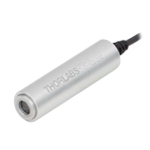 | 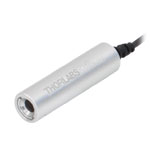 |  | 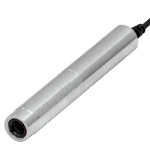 |  |
| Item # | CPS405 | CPS450 | CPS520a | CPS532b | CPS532-C2 |
| Type | Fixed | Fixed | Fixed | Fixed | Fixed |
| Wavelength (Typical) | 405 nm | 450 nm | 520 nm | 532 nm | 532 nm |
| Power (Typical) | 4.5 mW | 4.5 mW | 4.5 mW | 4.5 mW | 0.9 mW |
| Laser Safety Class | 3R | 3R | 3R | 3R | 2 |
| Beam Shapec (Click for Profile) | 3.8 mm x 1.8 mm | 3.2 mm x 1.0 mm | 4.6 mm x 1.7 mm | Ø3.5 mm | Ø3.5 mm |
| Housing Dimensions | Ø11.0 mm x 40 mm | Ø11.0 mm x 40 mm | Ø11.0 mm x 40 mm | Ø11.0 mm x 72.8 mm | Ø11.0 mm x 72.8 mm |
| Specifications |

| Click Image for Full View (Not to Scale) | 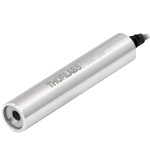 | 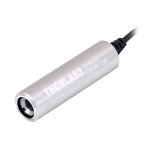 | 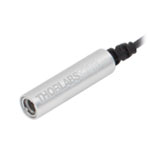 | 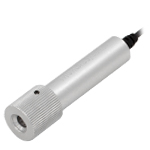 |
| Item # | CPS635Ra | CPS635 | CPS635S | CPS635Fb |
| Type | Fixed | Fixed | Fixed | Adjustable |
| Wavelength (Typical) | 635 nm | 635 nm | 635 nm | 635 nm |
| Power (Typical) | 1.2 mW | 4.5 mW | 4.5 mW | 4.5 mW |
| Laser Safety Class | 3R | 3R | 3R | 3R |
| Beam Shapec (Click for Profile) | Ø2.9 mm | 4.5 mm x 1.0 mm | 3.8 mm x 1.2 mm | Collimated 5.0 mm x 1.9 mm |
| Housing Dimensions | Ø11.0 mm x 58.0 mm | Ø11.0 mm x 40.0 mm | Ø8.0 mm x 30 mm | Ø11.0 mm x 54 mm |
| Specifications |

| Click Image for Full View (Not to Scale) | 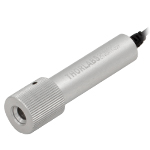 |  | 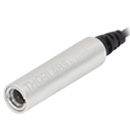 |
| Item # | CPS650Fa | CPS670Fa | CPS780S |
| Type | Adjustable | Adjustable | Fixed |
| Wavelength (Typical) | 650 nm | 670 nm | 780 nm |
| Power (Typical) | 4.5 mW | 4.5 mW | 2.5 mW |
| Laser Safety Class | 3R | 3R | 3R |
| Beam Shapeb (Click for Profile) | Collimated 5.0 mm x 2.4 mm | Collimated 5.0 mm x 2.4 mm | 3.8 mm x 1.6 mm |
| Housing Dimensions | Ø11.0 mm x 54 mm | Ø11.0 mm x 54 mm | Ø8.0 mm x 30 mm |
| Specifications |

| Click Image for Full View (Not to Scale) | 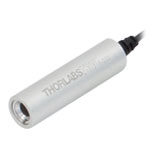 | 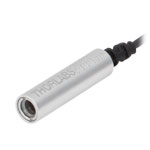 |
| Item # | CPS830 | CPS830S |
| Type | Fixed | Fixed |
| Wavelength (Typical) | 830 nm | 830 nm |
| Power (Typical) | 3.0 mW | 3.0 mW |
| Laser Safety Class | 3R | 3R |
| Beam Shapea (Click for Profile) | 4.4 mm x 1.1 mm | 4.0 mm x 1.3 mm |
| Housing Dimensions | Ø11.0 mm x 40 mm | Ø8.0 mm x 30 mm |
| Specifications |
| Click Image for Full View (Not to Scale) | 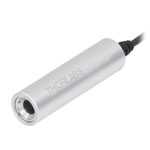 | 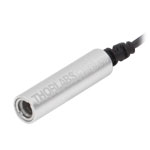 | 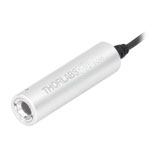 | 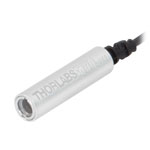 |
| Item # | CPS850 | CPS850S | CPS980 | CPS980S |
| Type | Fixed | Fixed | Fixed | Fixed |
| Wavelength (Typical) | 850 nm | 850 nm | 980 nm | 980 nm |
| Power (Typical) | 3.5 mW | 3.5 mW | 4.5 mW | 4.5 mW |
| Laser Safety Class | 3R | 3R | 3R | 3R |
| Beam Shapea (Click for Profile) | 4.5 mm x 1.2 mm | 3.8 mm x 1.5 mm | 3.8 mm x 1.8 mm | 3.8 mm x 1.8 mm |
| Housing Dimensions | Ø11.0 mm x 40 mm | Ø8.0 mm x 30 mm | Ø11.0 mm x 40 mm | Ø8.0 mm x 30 mm |
| Specifications |

Video G5.1 焦点調整CPSシリーズレーザーモジュールの取付方法
こちらのアダプタは、レーザーモジュールの筐体をSM1レンズチューブ、30 mm ケージシステム、 Ø12 mm~Ø12.7 mm(Ø1/2インチ)ポスト、Ø12 mm~Ø12.7 mm(Ø1/2インチ)またはØ25.0 mm~Ø25.4 mm(Ø1インチ)光学素子用マウントに取り付ける際に使用します。 詳細については「概要」タブの用途例の写真をご覧ください。アダプタAD8FとAD11Fは取付けキットの付属品としてもご提供しております。詳細は下記をご覧ください。
アダプタKAD8FとKAD8NT、KAD11FとKAD11NTは、±6°のあおり調整(ピッチ&ヨー)が可能です。 アダプタの前面プレートに付いている2つの80 TPI精密調整ネジであおり調整(ピッチ&ヨー)をします。その際には、2.0 mmの六角レンチをご使用ください。
レーザーモジュールCPS635F、CPS650FならびにCPS670Fに付いている焦点調整用の刻み付きノブは、取り付けアダプタの内孔よりも大きくなっていますのでご注意ください。 レーザーモジュールに取り付ける際には、Video G5.1のようにコリメート型と同様の方法でノブを取り外すことができます。 取り外す前にノブを固定している止めネジ(セットスクリュ)を緩めてください。緩めずに作業するとネジを破損させる恐れがあります。 また、初めにコードとフォノプラグをアダプタに通してからモジュールに取り付けてください。
| Click Image to Enlarge |  |  |  |  |  |  |  |  |
| Item # | AD8F | KAD8F | KAD8NT | AD11BA | AD11F | AD11NT | KAD11F | KAD11NT |
| Description | Externally SM1-Threaded Adapter | Externally SM1-Threaded Kinematic Adapter with Pitch and Yaw Adjustment | Unthreaded Kinematic Adapter with a 1" Outer Diameter and Pitch and Yaw Adjustment | Unthreaded Adapter with a 1/2" Outer Diameter | Externally SM1-Threaded Adapter | Unthreaded Adapter with a 1" Outer Diameter | Externally SM1-Threaded Kinematic Adapter with Pitch and Yaw Adjustment | Unthreaded Kinematic Adapter with a 1" Outer Diameter and Pitch and Yaw Adjustment |
| Diode Module Housing Diameter | 8 mm | 11 mm | ||||||

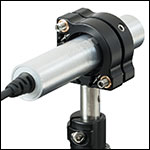
Click to Enlarge
Figure G6.1 レーザーモジュールCPS635Rを取り付けたMK11F(/M)
- Ø11 mm半導体レーザーモジュールをしっかりと固定
- 角度範囲:±4°
- コンパクトな設置面積:20.0 mm x 13.3 mm(公称値)
- 分解能:2個のM2.5 x 0.20精密アジャスタにより、それぞれ1回転に付き13 mrad (0.77°)
- 2つのM3取付け穴により右手系、左手系のどちらも構成可能
当社の円筒形部品用ミニシリーズキネマティックマウントは、上記掲載のØ11 mm半導体レーザーモジュールを取り付けるには最もコンパクトな製品です。 こちらの2アジャスタ付きキネマティックマウントの設置面積は20.0 mm x 13.2 mm(公称値)で、当社のミニシリーズのキネマティックミラーマウントと同じです。円筒形の部品は、先端がナイロン製の固定ネジと2重穴との組合せで、3点支持で固定されます。 この固定ネジと2個のM2.5 x 0.20アジャスターネジには、すべて0.050インチ(1.3 mm)六角レンチ(付属しておりません)を使用できます。
調整用としては、当社では便利なつまみネジ型の0.050インチ(1.3 mm)六角レンチをお勧めしています。またアジャスターネジを任意の位置で固定したり、ハードストップを構成したりするために、固定用カラーとスパナレンチもご用意しております。

| Table G7.2 Mounting Kit Components | ||||
|---|---|---|---|---|
| Item # | CPSK1a | CPSK1/Mb | CPSK2a | CPSK2/Mb |
| Laser Module Mounting Adapter | AD8F | AD11F | ||
| Kinematic Mirror Mount | KM100T | |||
| Ø1/2" Post | TR3 | TR75/M | TR3 | TR75/M |
| Ø1/2" Post Holder | PH3 | PH75/M | PH3 | PH75/M |
| Mounting Base | BA2 | BA2/M | BA2 | BA2/M |
| Power Supply | DS5 + CPSA | |||
- 必要な取付け用部品すべてと 5 V電源が付属
- 当社のレーザーモジュールに対応
- CPSK1/M: Ø8 mmモジュール筐体
- CPSK2/M: Ø11 mmモジュール筐体
- 5 V電源とUSB 2.0 - 2.5 mmフォノケーブルCPSAが付属
こちらのレーザーモジュール取付けキットには、当社のレーザーモジュールを取り付けて駆動するための部品が全て入っております(電源とUSBからCPSレーザに電源を供給するためのアダプタ、レーザーモジュールをマウントに固定する六角レンチ)。Ø8 mm筐体付きモジュールにはCPSK1/M、Ø11 mm筐体付きモジュール用CPSK2/Mをお選びください。
キットに含まれる部品のリストはTable G7.2をご覧ください。ほかの取付け方法については下記の取付けアダプタのラインナップをご覧ください(キットに対応するためにはSM1外ネジ付きのアダプタをお選びください)。

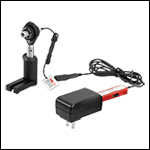
Click to Enlarge
Figure G8.1 USB電源アダプタとアダプタケーブルCPSA。CPSレーザに使用が可能です。
- CPSレーザーモジュールに対応
- ケーブル長さ1.78 m、2.5 mmフォノプラグ付き
USB 2.0コネクタ付きの2.5 mmUSB-フォノプラグアダプターケーブルCPSAは長さ1.78 m、低ノイズ、ON/OFFスイッチ付きのケーブルです。このアダプターケーブルにより、CPSレーザーモジュールをUSB電源アダプタに接続可能です。

*本製品は日本国内での販売はしておりません。市販の5V(DC) 2A出力のバッテリであれば本機を代用いただけます。
CPSシリーズと接続する際にはUSB-2.5mmフォノプラグ付ケーブル(#CPS-CABLE)が必要になりますが、 ケーブルのみ別途販売いたしますので、当社までお問い合わせください。
- Portable USB Battery Pack with 5 VDC and up to 2 A Output
- Compatible with CPS Laser Modules and USB-Powered Devices
- 10 000 mAh Capacity
Thorlabs offers the CPS1 Battery Pack for powering our CPS laser modules and other USB-powered devices. The CPS1 battery pack outputs 5 VDC at up to 2 A, and offers 10 000 mAh capacity. A fully charged CPS1 battery pack can power any CPS laser module for at least 36 hours of continuous operation. The pack includes a USB-to-Micro-USB cable for charging and a custom USB-to-Phono cable for powering the CPS laser module. To activate the battery, simply push the power button once. The pack may be charged using standard 5 V USB chargers for portable devices or using a computer USB port. While the battery pack is charging, it can still supply power to an attached laser module.
The CPS1 Battery Pack also includes an LED flashlight adjacent to the micro-USB port. The flashlight is activated and deactivated by holding the power for two seconds.
When connecting the CPS Diode Module, the module and adapter should be connected first. Then the adapter cable should be plugged into the isolated power supply to avoid a short circuit in the phono jack. Please note that the USB adapter included with this battery pack is not intended to be used with power supplies that are not current-limited or isolated from ground, such as some computers or laptops.
 Products Home
Products Home















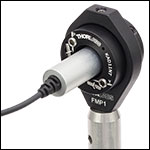
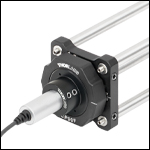


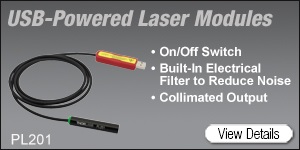
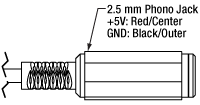
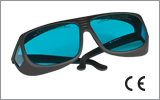
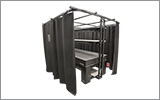
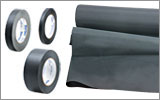
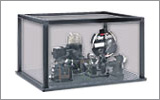
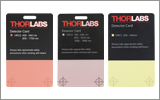
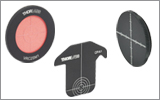
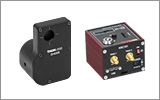
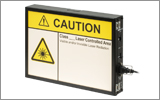
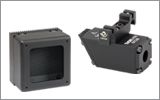
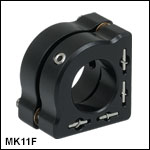
 ズーム
ズーム
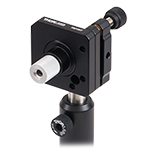
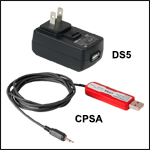
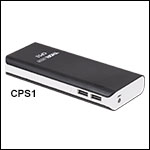
 小型レーザーモジュールフォノジャック付き
小型レーザーモジュールフォノジャック付き